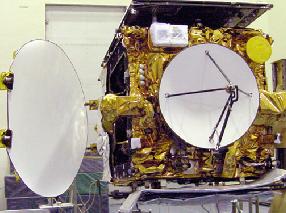|
EDUSAT - EDUCATIONAL Satellite Series |
|
EDUSAT
EDUSAT is the first Indian satellite built exclusively for serving the educational sector and it was launched sucessfully by GSLV-F01 on 20-9-2004. It is mainly intended to meet the demand for an interactive satellite based distance education system for the country. It strongly reflects India’s commitment to use space technology for national development, especially for the development of the population in remote and rural locations.
The 1950 kg EDUSAT was launched from Satish Dhawan Space Centre (SDSC) SHAR, Sriharikota, into a Geosynchronous Transfer Orbit (GTO) by ISRO’s Geosynchronous Satellite Launch Vehicle (GSLV). From GTO, EDUSAT will reach the 36,000 km high Geostationary Orbit (GSO) by firing, in stages, its on board Liquid Apogee Motor (LAM). In GSO, the satellite will be co-located with KALPANA-1 and INSAT-3C satellites at 74 deg East longitude.
Compared to the satellites launched in the INSAT series so far, EDUSAT will have several new technologies. The spacecraft is built around a standardised spacecraft bus called I-2K. It has a multiple spot beam antenna with 1.2 m reflector to direct precisely the Ku band spot beams towards their intended regions of India, a dual core bent heat pipe for thermal control, high efficiency multi-junction solar cells and an improved thruster configuration for optimised propellant use for orbit and orientation maintenance. The satellite uses radiatively cooled Ku-band Travelling Wave Tube Amplifiers (TWTAs) and dielectrically loaded C-band DEMULTIPLEXER for its communication payloads.
EDUSAT carries five Ku-band transponders providing spot beams, one Ku-band transponder providing a national beam and six Extended C-band transponders with national coverage beam. It will join the INSAT system that already has more than 130 transponders in C-band, Extended C-band and Ku-band providing a variety of telecommunication and television services. Courtesy: ISRO


